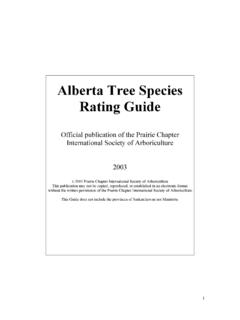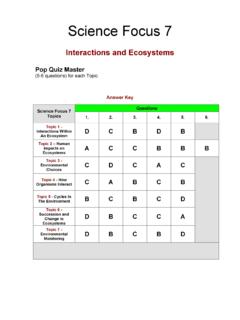Transcription of boreal wetlands Fens - Wetlands Alberta
1 FenShrubby Fenboreal Wetlands FensFens are peatlands with deep organic (peat) deposits (>40 cm) and are influenced by slow, lateral water movement. Water sources have been in contact with nutrient-rich surface and/or groundwater making fens more productive and biologically diverse than bogs. fens can be treed, shrubby or open. Often referred to as muskeg, fens are the most extensive Wetlands in the western boreal Ecological Benefitsj Known as the green rivers of the boreal , fens transport large volumes of water and nutrients across the land- scape; help to regulate water flow j Help prevent downstream flooding by absorbing precipitation and run-offj Due to deep organic deposits, fens store large amounts of carbon and help to moderate climate change j Provide important habitat for the threatened woodland caribou Types of fens j Treed fens : Sparsely vegetated and stunted (<10 m) tamarack, sometimes mixed with black spruce, shrubs, sedges and mossesj Shrubby fens : sparse to medium density.
2 Short (<2 m) shrubs ( bog birch and willow) mixed with sedges and mossesj Graminoid (open) fens : dominated with sedges, mosses and herbs ( buckbean) often interspersed with open water Fen ComplexGraminoid FenResourcesj Ducks Unlimited Canada Natural Values Fact Sheet Series ( )j Field Guide to the Wetlands of the boreal Plains Ecozone of Canada ( )j Ducks Unlimited Canada Western boreal Program ( ) Characteristics Vegetationj Plant species reflect nutrient and moisture gradientsj The plant communities of nutrient-poor fens more closely resemble those of bogs, while rich fens have more diverse and robust vegetationj Treed fens : trees (<10 m) make up 25-60% of surface area dominated by tamarack although black spruce can occur j Shrubby fens : shrubs (<2 m) dominate (>25%) with less than 25% tree cover common species are bog birch, willow and sweet galej Graminoid (open) fens .
3 Dominated by sedges, mosses and buckbean Hydrologyj Complex hydrology with surface, sub- surface and groundwater interactions j High water table (at or slightly below the surface) with lateral water flow often connecting wetland systems over vast distances mineral soilbcdefb tamarackc willowd sphagnum mosse dwarf bog-rosemaryf water sedgeg brown mossesh meadow horsetaili bog cranberryj bog birch1) black spruceboreal Wetlands fens Soilj Deep peat deposits (>40 cm) j Similar to bogs but with greater composition of sedge peatj Decomposition is slow due to the wet, cool, anoxic (oxygen- deprived) environment, resulting in the accumulation of deep organic depositsj Depending on water sources and nutrient availability, fens can be either nutrient rich or nutrient poor j Two distinct layers (right): Acrotem: the living layer, top 30-50 cm Catotelm: the lower, non-living layer ghij1)organic materialwater tablePatterned Fen complex with treed, shrubby and open graminoid componentsWoodland Caribou020406080cmacrotemcatotelm







